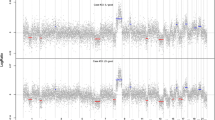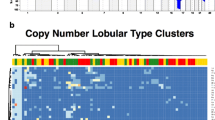Abstract
Lobular carcinoma in situ (LCIS) of the breast is generally considered an indicator for a bilaterally increased risk of invasive breast cancer (IBC). However, as recent studies suggested a clonal relationship between a subset of synchronous LCIS and invasive lobular carcinomas (ILC), we aimed to examine a possible precursor role for LCIS and IBC occurring in the same breast at a later time. Out of a consecutive series of 88 LCIS, nine patients developed IBC (5 ILC and 4 invasive ductal carcinomas) between 2 and 10 years after initial biopsy. For each case, mitochondrial DNA heteroplasmy was analyzed in normal mammary gland epithelia, LCIS and IBC by PCR, direct DNA sequencing and phylogenetic tree clustering. Two cases of LCIS and ILC showed identical patterns of heteroplasmy. In one further case, additional mtDNA mutations were present in the ILC following LCIS. The remaining two cases of ILC and all 4 IDC were clonally unrelated to the previously diagnosed LCIS. While the overall risk for the development of invasive breast cancer following LCIS is relatively low and the majority of cases are clonally unrelated, our data clearly show that some LCIS eventually do progress to ILC. Thus, LCIS represents both an indicator lesion for an increased risk of subsequent invasive breast cancer and in some cases a precursor of ILC.

Similar content being viewed by others
References
Foote FW, Stewart FW (1941) Lobular carcinoma in situ: a rare form of mammary cancer. Am J Pathol 17:491–495
Hutter RVP, Foote FW (1969) Lobular carcinoma in situ: incidence and treatment. Cancer 31:105–109
Haagensen CD, Lane N, Lattes R et al (1978) Lobular neoplasia (so-called lobular carcinoma in situ) of the breast. Cancer 42:737–769
Page DL, Kidd TE, Dupont WD et al (1991) Lobular neoplasia of the breast: higher risk for subsequent invasive cancer predicted by more extensive disease. Hum Pathol 22:1232–1239
Ottesen GL, Graversen HP, Blichert-Toft M et al (1993) Lobular carcinoma in situ of the female breast. Short-term results of a prospective nationwide study. The Danish Breast Cancer Cooperative Group. Am J Surg Pathol 17:14–21
Fisher B, Costantino JP, Wickerham L et al (1998) Tamoxifen for prevention of breast cancer: report of the National Surgical Adjuvant Breast and Bowel Project P-1 study. J Natl Cancer Inst 90:1371–1388
Ottesen GL, Graversen HP, Blichert-Toft M et al (2000) Carcinoma in situ of the female breast. 10 year follow-up results of a prospective nationwide study. Breast Cancer Res Treat 62:197–210
Shin SJ, Rosen PP (2002) Excisional biopsy should be performed if lobular carcinoma in situ is seen on needle core biopsy. Arch Pathol Lab Med 126:697–701
Elsheikh TM, Silverman JF (2005) Follow-up surgical excision is indicated when breast core needle biopsies show atypical lobular hyperplasia or lobular carcinoma in situ: a correlative study of 33 patients with review of the literature. Am J Surg Pathol 29:534–543
Chuba PJ, Hamre MR, Yap J et al (2005) Bilateral risk for subsequent breast cancer after lobular carcinoma-in-situ: analysis of surveillance, epidemiology, and end results data. J Clin Oncol 23:5534–5541
Beute BJ, Kalisher L, Hutter RVP (1991) Lobular carcinoma in situ of the breast: clinical, pathologic, and mammographic features. AJR 157:257–265
Sonnenfeld MR, Frenna TH, Weidner N et al (1991) Lobular carcinoma in situ: mammographic-pathologic correlation of results of needle-directed biopsy. Radiology 181:363–367
Hwang ES, Nyante SJ, Yi Chen Y et al (2004) Clonality of lobular carcinoma in situ and synchronous invasive lobular carcinoma. Cancer 100:2562–2572
Morandi L, Marucci G, Foschini MP et al (2006) Genetic similarities and differences between lobular in situ neoplasia (LN) and invasive lobular carcinoma of the breast. Virchows Arch 449:14–23
Bratthauer GL, Tavassoli FA (2002) Lobular intraepithelial neoplasia: previously unexplored aspects assessed in 775 cases and their clinical implications. Virchows Arch 440:134–138
Berx G, Cleton-Jansen AM, Strumane K et al (1996) E-cadherin is inactivated in a majority of invasive human lobular breast cancers by truncation mutations throughout its extracellular domain. Oncogene 9:1919–1925
Anderson S, Bankier AT, Barrel BG et al (1981) Sequence and organization of the human mitochondrial genome. Nature 290:457–465
Chenna R, Sugawara H, Koike T et al (2003) Multiple sequence alignment with the Clustal series of programs. Nucleic Acids Res 31:3497–3500
Butler JM, Levin BC (1998) Forensic applications of mitochondrial DNA. Trends Biotechnol 16:158–162
Greaves LC, Preston SL, Tadrous PJ et al (2006) Mitochondrial DNA mutations are established in human colonic stem cells, and mutated clones expand by crypt fission. Proc Natl Acad Sci 103:714–719
Morandi L, Pession A, Marucci GL et al (2003) Intraepidermal cells of Paget’s carcinoma of the breast can be genetically different from those of the underlying carcinoma. Hum Pathol 34:1321–1330
Nomoto S, Yamashita K, Koshikawa K et al (2002) Mitochondrial D-loop mutations as clonal markers in multicentric hepatocellular carcinoma and plasma. Clin Cancer Res 8:481–487
Rosen PP, Kosloff C, Lieberman PH et al (1978) Lobular carcinoma in situ of the breast. Detailed analysis of 99 patients with average follow-up of 24 years . Am J Surg Pathol 2:225–251
Andersen JA (1974) Lobular carcinoma in situ. A long-term follow-up in 52 cases. Acta Pathol Microbiol Scand 82:519–533
Godwin JT (1952) Chronology of lobular carcinoma of the breast. Cancer 5:259–266
Fisher ER, Gregorio RM, Fisher B et al (1975) The pathology of invasive breast cancer: a syllabus derived from findings of the National Surgical Adjuvant Breast Project (Protocol No. 4). Cancer 36:1–85
Ellis IO, Galea M, Broughton N et al (1992) Pathological prognostic factors in breast cancer. II. Histological type. Relationship with survival in a large study with long-term follow-up. Histopathology 20:479–489
Fisher ER, Land SR, Fisher B et al (2004) Pathologic findings from the national surgical adjuvant breast and bowel project: twelve-year observations concerning lobular carcinoma in situ. Cancer 100:238–244
Dixon JM, Anderson TJ, Page DL et al (1982) Infiltrating lobular carcinoma of the breast. Histopathology 6:149–161
Acknowledgements
Part of this work was supported by a grant from the Heidelberg University (3542.2). The authors would like to thank A. Boenisch, S. Fendrich and W. Schmitz for excellent technical assistance.
Author information
Authors and Affiliations
Corresponding author
Rights and permissions
About this article
Cite this article
Aulmann, S., Penzel, R., Longerich, T. et al. Clonality of lobular carcinoma in situ (LCIS) and metachronous invasive breast cancer. Breast Cancer Res Treat 107, 331–335 (2008). https://doi.org/10.1007/s10549-007-9557-0
Received:
Accepted:
Published:
Issue Date:
DOI: https://doi.org/10.1007/s10549-007-9557-0




